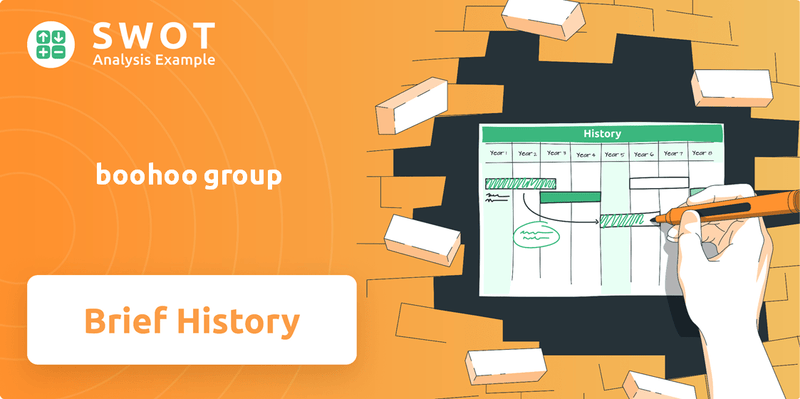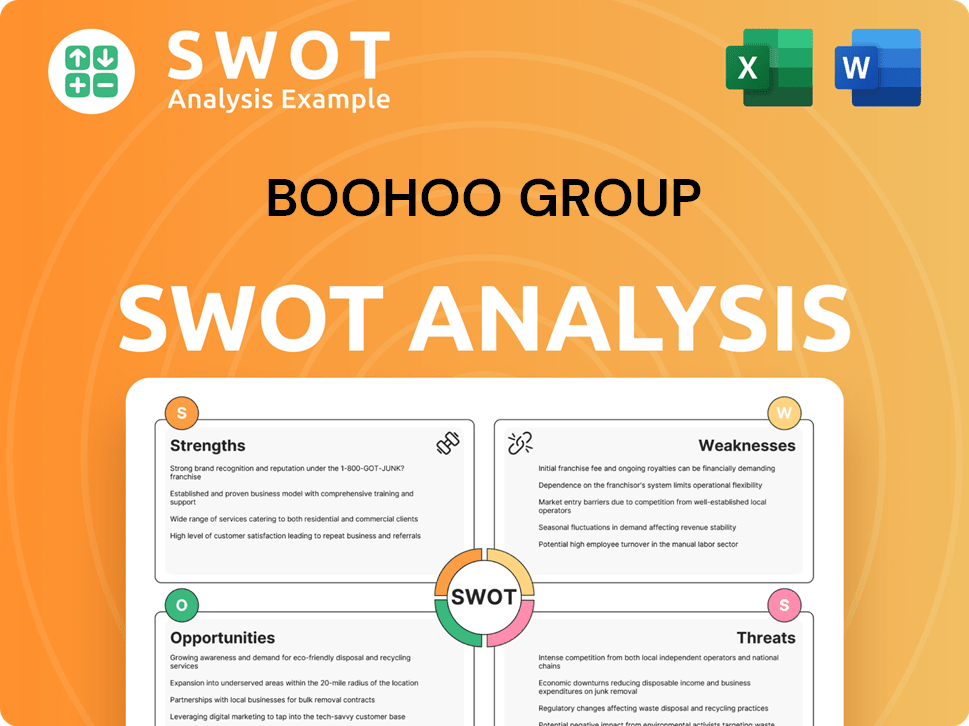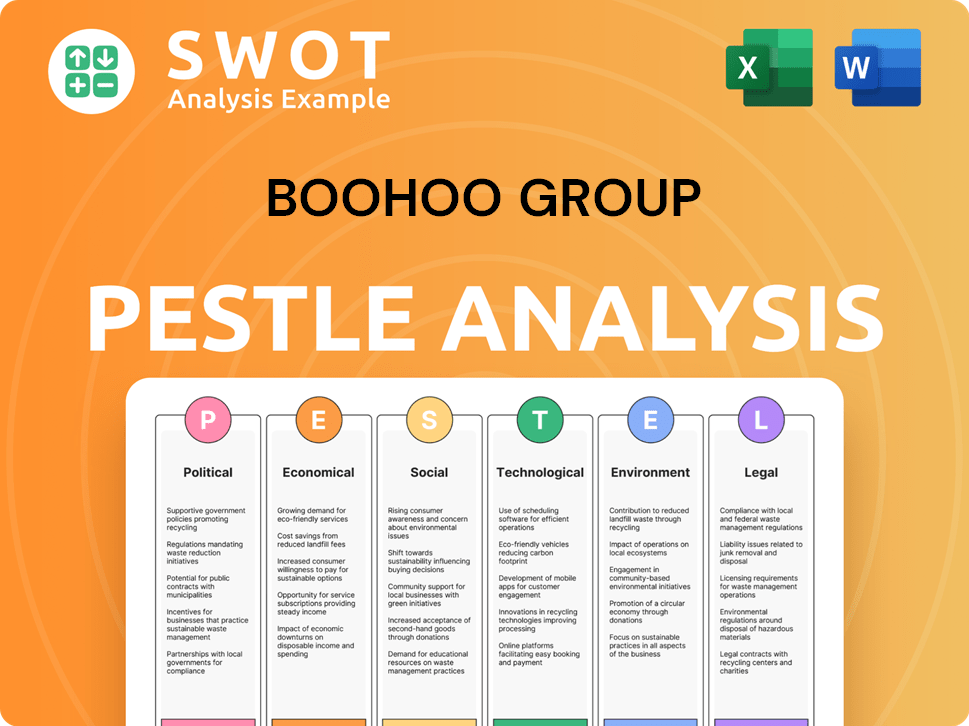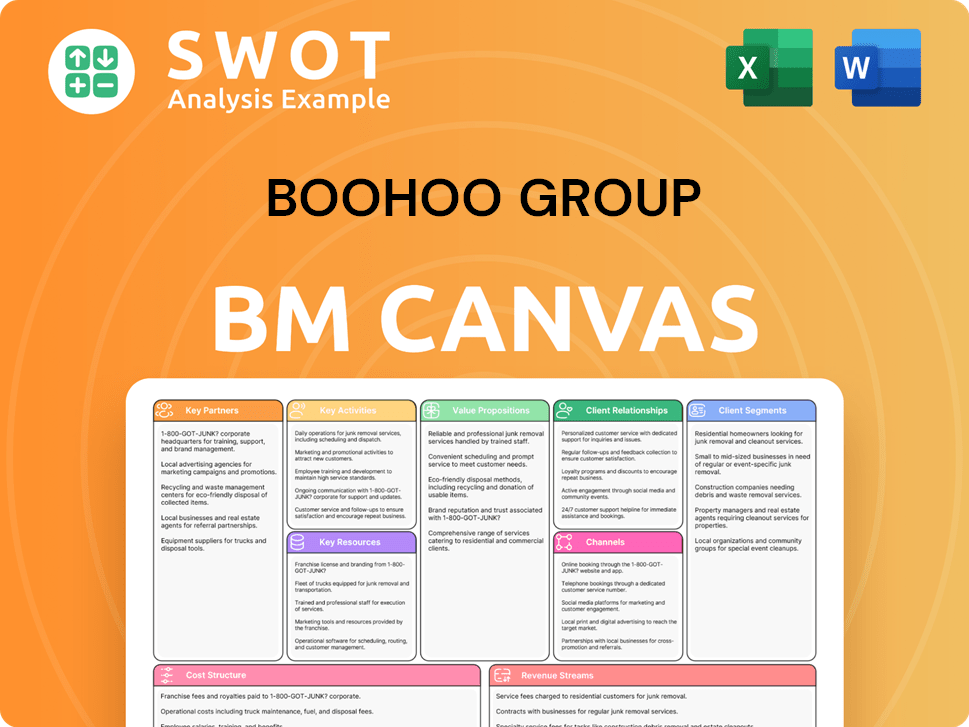boohoo group Bundle
What's the Story Behind Boohoo Group's Rise and Transformation?
Founded in 2006, the boohoo group SWOT Analysis reveals a fascinating journey through the fast-fashion world. From its Manchester beginnings, the

This deep dive into
What is the boohoo group Founding Story?
The story of the boohoo group began in Manchester, England, in 2006. It was founded by Mahmud Kamani and Carol Kane. They saw an opportunity to create a fast-fashion retailer that would operate exclusively online.
The founders brought experience from supplying high street chains. They aimed to cut out intermediaries, sell directly to customers, and offer trendy fashion at accessible prices with speedy delivery. Their initial goal was to provide the social generation with accessible and confident fashion choices globally.
The company's early business model was built around being online-only. This helped keep costs down and allowed for fast shipping, initially from UK-based operations. The company quickly gained momentum by using a direct sourcing model with local suppliers. This allowed them to quickly bring new clothing lines to market. Starting with a small team, they focused on their own-brand fashion clothing, offering over 36,000 products. In less than 15 years, the company grew from three employees to a global business with a workforce of over 5,000.
The founders identified a gap in the market for online-only fashion.
- The company focused on fast fashion, offering trendy clothing at affordable prices.
- A direct sourcing model enabled quick responses to fashion trends.
- Rapid growth was achieved, expanding from a small team to a global workforce.
- The strategy included leveraging local suppliers for efficient production.
boohoo group SWOT Analysis
- Complete SWOT Breakdown
- Fully Customizable
- Editable in Excel & Word
- Professional Formatting
- Investor-Ready Format

What Drove the Early Growth of boohoo group?
The early years of the boohoo group were marked by a focus on building a responsive supply chain, allowing it to quickly adapt to fashion trends. This agility, coupled with a 'test-and-repeat' model, enabled the company to efficiently bring new styles to market. By its initial public offering (IPO) in March 2014, the boohoo company had already established a significant customer base and global presence.
The boohoo group completed its IPO in March 2014, valuing the company at nearly £600 million. The IPO success saw Mahmud Kamani, a boohoo founder, receive £135 million and Carol Kane, another founder, receive £25 million. This financial boost fueled further expansion and strategic acquisitions, which were key to its growth.
In 2016, the boohoo group expanded its market reach with the launch of BoohooMan, a dedicated menswear site. This move targeted a new demographic, specifically men aged 16-24. This strategic expansion into menswear broadened the company's appeal and customer base.
The boohoo group adopted a multi-brand strategy, acquiring several key brands to diversify its offerings. Acquisitions included Nasty Gal in February 2017, MissPap in 2019, and PrettyLittleThing (PLT) in 2020. These acquisitions significantly broadened the company's customer base and product range, solidifying its position in the boohoo online fashion market.
In mid-2019, the boohoo group expanded into more mature fashion segments by acquiring the intellectual property and online operations of Karen Millen and Coast. The company also invested heavily in its distribution network, increasing warehousing capacity. Recent improvements to its Sheffield warehouse automation have led to significant cost savings and increased efficiency, contributing to the overall success of the boohoo business model.
boohoo group PESTLE Analysis
- Covers All 6 PESTLE Categories
- No Research Needed – Save Hours of Work
- Built by Experts, Trusted by Consultants
- Instant Download, Ready to Use
- 100% Editable, Fully Customizable

What are the key Milestones in boohoo group history?
The boohoo group has experienced significant growth, marked by strategic acquisitions and a strong online presence. The boohoo company's journey from its inception to its current status has been shaped by key milestones and strategic decisions.
| Year | Milestone |
|---|---|
| 2006 | Founded in Manchester, England, marking the beginning of boohoo's journey in the online fashion industry. |
| 2013 | boohoo group plc was listed on the London Stock Exchange, which helped boost its expansion. |
| 2016 | Acquisition of PrettyLittleThing, expanding boohoo's portfolio of boohoo brands and customer base. |
| 2017 | Acquisition of Nasty Gal, further diversifying the company's offerings in the online fashion market. |
| 2020 | Acquisition of the online business of Karen Millen and Coast. |
| 2021 | Acquisition of the Debenhams brand and website, transforming it into a digital marketplace. |
| 2024 | Sophie Rycroft appointed as Group Director of Responsible Sourcing to address supply chain and ethical concerns. |
A key innovation for the boohoo group is its 'test-and-repeat' model, allowing quick adaptation to fashion trends and rapid product launches. This agile approach has enabled the company to stay ahead in the competitive boohoo online fashion market.
The company's agile e-commerce model enables it to quickly respond to changing fashion trends and customer preferences. This model is crucial for maintaining a competitive edge in the fast-paced online fashion industry.
Acquisitions of brands like PrettyLittleThing, Nasty Gal, and Debenhams have expanded the boohoo group's market reach. These acquisitions have been instrumental in boosting the boohoo business model and overall growth.
The 'test-and-repeat' model allows for rapid product launches and quick adjustments based on customer feedback. This approach supports the boohoo group's ability to stay current with fashion trends.
The transformation of Debenhams into a digital marketplace has been a successful strategic move. This has allowed the boohoo group to diversify its revenue streams and enhance its market position.
The boohoo group has faced challenges, particularly regarding its supply chain and ethical practices, which led to scrutiny and the need for improvements. Financially, the company has experienced revenue declines, prompting cost-cutting measures and strategic adjustments.
Allegations of worker exploitation and poor working conditions at some suppliers have presented challenges. These issues have led to independent reviews and efforts to improve ethical standards.
The boohoo group experienced a decline in revenues, with group revenues declining by 15% to £619.8 million in the first half of fiscal year 2025 (ending August 31, 2024). This downturn is attributed to challenging market conditions and increased return rates.
boohoo group has undertaken significant cost-cutting initiatives, including reducing operating costs by £128 million compared to the previous year. The company also secured a new £222 million debt refinancing deal in October 2024.
boohoo group Business Model Canvas
- Complete 9-Block Business Model Canvas
- Effortlessly Communicate Your Business Strategy
- Investor-Ready BMC Format
- 100% Editable and Customizable
- Clear and Structured Layout

What is the Timeline of Key Events for boohoo group?
The boohoo group, a prominent player in the boohoo online fashion industry, has a dynamic history marked by rapid expansion and strategic shifts. Founded in Manchester in 2006 by Mahmud Kamani and Carol Kane, the company quickly grew, completing its IPO in March 2014 and reaching a valuation of nearly £600 million. Over the years, the boohoo company expanded its portfolio through acquisitions, including Nasty Gal, MissPap, Karen Millen, and Coast. However, the boohoo history also includes challenges, such as allegations of poor working conditions in 2020, which led to an independent review. More recently, the company has undergone significant changes, including a rebranding to Debenhams Group in March 2025, signaling a strategic pivot towards a marketplace-led model. The boohoo brands have been a significant part of the company's growth.
| Year | Key Event |
|---|---|
| 2006 | The boohoo group was founded in Manchester by Mahmud Kamani and Carol Kane. |
| March 2014 | Boohoo completed its Initial Public Offering (IPO) on the London Stock Exchange, valuing the company at nearly £600 million. |
| 2016 | BoohooMan, a standalone menswear site, was launched. |
| February 2017 | Boohoo acquired Nasty Gal. |
| 2019 | Boohoo acquired MissPap, and the IP and online operations of Karen Millen and Coast. |
| July 2020 | Allegations of poor working conditions and underpayment in Leicester factories emerged, leading to an independent review. |
| January 2021 | Boohoo acquired the Debenhams brand and website. |
| September 2021 | Boohoo Group increased its warehousing and distribution capacity to support over £4 billion of net sales. |
| 2023 | Boohoo Group's annual revenue for the fiscal year ending February 28, 2023, was £1.768 billion. |
| July 2024 | Sophie Rycroft was appointed as the new group director of responsible sourcing. |
| August 31, 2024 | Boohoo Group reported a trailing 12-month revenue of $1.7 billion. Its revenue for the six months ending August 31, 2024, declined by 15% to £619.8 million. |
| October 2024 | John Lyttle announced his intention to step down as CEO. Boohoo Group secured a £222 million debt refinancing deal. |
| November 2024 | Dan Finley was named the new Group Chief Executive. |
| December 2024 | Boohoo Group sold its London head office for £49.5 million to strengthen its balance sheet. |
| January 2025 | Shareholders voted against Frasers Group's demands to remove co-founder Mahmud Kamani from the board. |
| February 2025 | Phil Ellis was appointed as the new Group Chief Financial Officer. |
| March 2025 | Boohoo Group officially rebrands to Debenhams Group, pivoting to a marketplace-led model. |
The Debenhams Group is now focused on a marketplace-led model, aiming to replicate the successful Debenhams marketplace across its entire portfolio. This shift is led by new CEO Dan Finley. This strategy aims to capitalize on the e-commerce market.
The company is prioritizing digital transformation and brand diversification, with a goal to include around 10,000 brands. This approach aims to increase Gross Merchandise Value (GMV) and improve EBITDA performance in the second half of fiscal year 2025. The boohoo business model is evolving.
The Debenhams Group envisions becoming a multi-billion pound gross merchandise value business. It aims for an EBITDA margin on net sales of approximately 20% in the medium term. The boohoo group is working on its financial performance.
The company faces ongoing challenges from intense competition and changing consumer preferences. Despite these challenges, the Debenhams Group's future is centered on achieving sustainable growth and profitability. The boohoo's growth strategy is evolving.
boohoo group Porter's Five Forces Analysis
- Covers All 5 Competitive Forces in Detail
- Structured for Consultants, Students, and Founders
- 100% Editable in Microsoft Word & Excel
- Instant Digital Download – Use Immediately
- Compatible with Mac & PC – Fully Unlocked

Related Blogs
- What is Competitive Landscape of boohoo group Company?
- What is Growth Strategy and Future Prospects of boohoo group Company?
- How Does boohoo group Company Work?
- What is Sales and Marketing Strategy of boohoo group Company?
- What is Brief History of boohoo group Company?
- Who Owns boohoo group Company?
- What is Customer Demographics and Target Market of boohoo group Company?
Disclaimer
All information, articles, and product details provided on this website are for general informational and educational purposes only. We do not claim any ownership over, nor do we intend to infringe upon, any trademarks, copyrights, logos, brand names, or other intellectual property mentioned or depicted on this site. Such intellectual property remains the property of its respective owners, and any references here are made solely for identification or informational purposes, without implying any affiliation, endorsement, or partnership.
We make no representations or warranties, express or implied, regarding the accuracy, completeness, or suitability of any content or products presented. Nothing on this website should be construed as legal, tax, investment, financial, medical, or other professional advice. In addition, no part of this site—including articles or product references—constitutes a solicitation, recommendation, endorsement, advertisement, or offer to buy or sell any securities, franchises, or other financial instruments, particularly in jurisdictions where such activity would be unlawful.
All content is of a general nature and may not address the specific circumstances of any individual or entity. It is not a substitute for professional advice or services. Any actions you take based on the information provided here are strictly at your own risk. You accept full responsibility for any decisions or outcomes arising from your use of this website and agree to release us from any liability in connection with your use of, or reliance upon, the content or products found herein.